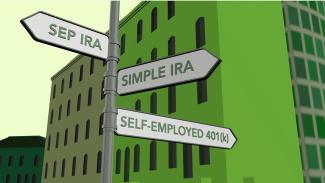
Are you Self-Employed? You Have Savings Options Available
Being self-employed can provide a higher level of autonomy in your work but it does come with more responsibilities such as retirement plan savings’ options. In a typical employee scenario, there are employer-sponsored retirement plans in place which can help one automatically save. This can also be accomplished by self-employed individuals, but it requires a few extra steps. Below are some of the retirement plan options that can be considered:
Solo 401(k)
This type of plan is best suited for a self-employed individual with no employees, apart from a spouse. In a traditional 401(k) setup, contributions made by participants and matching contributions are made by the employer up to a certain percentage.
Under a Solo 401(k), a self-employed individual can make contributions into this plan as a participant AND as an employer. For 2019, the contribution as a participant can be up to either $19,000 or $25,000, if one is age 50+. As for the employer contribution, a contribution of up to 25% of compensation can be made to the solo 401(k). Compensation, for Solo 401(k) purposes, is defined as: net profit less half of one’s self-employment tax and participant contributions. There is a limit of compensation that can be used to factor the employer contribution, which for 2019 is the first $280,000 of your compensation.
There is a maximum to how to much can be contributed to a Solo 401(k) from both employer and participant contributions. For 2019, it is $56,000 or $62,000 if one is age 50+. A Solo Roth 401(k) may also be a viable option dependent on one’s income and tax rate levels. Such details go beyond the scope of this blog and may require further planning.
SEP IRA
This type of plan is best suited for self-employed individuals with little to no employees. Like a Solo 401(k), the total contribution limit is $56,000 for 2019. However, SEP IRA’s do not allow for age 50+ catchup contributions as employees are not allowed to make contributions, only the employer.
The way this works is that employers must contribute an equal percentage of salary for all eligible employees, of which the employer (the self-employed individual) is included as one. For example, if the employer were to make a 5% contribution based on his/her pay, then a 5% contribution must also be made to all other employees based on their pay.
Self-employed individuals may favor setting up a SEP IRA over a Solo 401(k) as there is less administrative work to maintain due to the accounts being owned and managed by each employee, and less paperwork to initially set one up.
SIMPLE IRA
These are best suited for self-employed individuals with larger businesses of up to 100 employees. The rules for a SIMPLE IRA are different than a SEP IRA or a Solo 401(k). Unlike a SEP IRA, employees can make contributions which has a limit for 2019 is $13,000 or $16,000 if one is age 50+. Total contributions between employer and employee cannot exceed $19,000 for 2019. Matching contributions from the employer are deductible as a business expense. Employers are, however, required to make a matching contribution, which is either a 2% fixed or 3% matching contribution.
Similarly, a SIMPLE IRA is easier to setup than a Solo 401(k). There is less administrative burden on the employer’s part as these IRA are owned and managed by each employee.
While there are other options out there for self-employed individuals, these are typically the most common types of plans that have favorable advantages. Setting up these types of plans are relatively straightforward, albeit requiring some extra steps. If further guidance is needed, it is recommended that you speak to a financial planner to ensure which plan fits your needs.
Weingarten Associates is an independent, fee-only Registered Investment Advisor in Lawrenceville, New Jersey serving Princeton, NJ as well as the Greater Mercer County/Bucks County region. We make a difference in the lives of our clients by providing them with exceptional financial planning, investment management, and tax advice.

